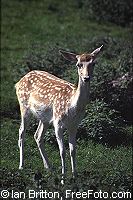Research shows how and why Europe should reduce animal-vehicle collisions
Two separate studies carried out by Spanish and German researchers have highlighted the need for a strategy to reduce animal-vehicle collisions on Europe's roads, as well as a model that could be used to guide this strategy. Researchers from Madrid University, led by Juan E. Malo, have succeeded in developing models that can predict the best location for mitigation measures, such as fences or underpasses, and thus contribute to both wildlife survival and road safety. The study was carried out in the Soria Province of Spain and focused on those roads and specific locations with a history of animal-vehicle collisions. A database of such accidents was used to find both road sections of one kilometre (km) in length with high rates of collision as well as points of collision on the road system at a 0.1 km scale. Dr Malo et al then used logistic regression to investigate the relationship between the incidence of collision and local habitat features. 'The number of collisions with large mammals is increasing in developed countries, and may be of the order of several million globally each year,' states the research paper 'Can we mitigate animal-vehicle accidents using predictive models?', published in the Journal of Applied Ecology. Vehicle collisions with large mammals not only result in death for the mammal in the majority of cases, but also result in human injury as well as material costs. US researchers have estimated that vehicle collisions with large mammals cost over 1,500 USD (1,247 euro) per collision. Approximately four per cent of collisions with medium sized animals such as deer result in human injury, while between 14 and 18 per cent of accidents involving larger mammals such as moose result in injury, according to US research. In the Soria Province of Spain, three species were involved in more than 98 per cent of recorded accidents: roe deer, red deer and wild boar. A few collisions were also recorded as having taken with foxes, badgers, hares and wild cats. These animals, and others, live in numerous other regions in Europe, and the researchers therefore believe that their research can be used to mitigate collisions in areas outside Spain. Numerous measures have been used in attempts to reduce road traffic accidents involving animals, including fences, mirrors, overpasses and underpasses, road signs and whistles. However, no single method has proven totally effective. It would entail great financial cost to install physical structures along long stretches of road, and less expensive measures have proved ineffective when long stretches are involved. 'Models that predict the most likely collision points can be of practical value,' Dr Malo et al therefore surmise. This is the first study to analyse both stretches of road and individual points on roads, and is only the second modelling study on animal-vehicle collision mitigation to be carried out in Europe. The research showed that road sections with high collision rates often have high forest cover, low crop cover, low numbers of buildings and high habitat diversity. A model developed by the team achieved significant predictive success during validation, classifying 70 per cent of road sections correctly. Specific collision points were found to typically have no guard rails or lateral embankments, and to not be in the vicinity of underpasses or crossroads. They also tended to have hedges or woodland near the road. The predictive model created by the researchers for these specific collision points was found to be even more successful, accurately predicting 85.1 per cent of collision points during validation. 'The results from the two sets of analysis in this study could help in the design of mitigation measures at two complementary spatial scales: the road section and the specific collision point,' conclude Dr Malo et al. 'The use of models at a landscape scale encourages mitigation investment to focus on areas where it could be most effective,' they write. Using the model to predict specific collision points could have similar results. The authors propose the combined use of lateral banks, fences, guard rails and vegetation in these areas in order to funnel animal movements and thus reduce collisions. These results are likely to be of interest to a variety of people, including road planners and road users. They are also likely to be welcomed by wildlife campaigners, and in particular those working with endangered species. One such endangered species at particular risk from road traffic accidents is the Eurasian lynx. A group of researchers led by Stephanie Kramer-Schadt from the UFZ Centre for Environmental Research in Leipzig, Germany and involving others from Spain and Switzerland, has developed a model to assess the probability of the lynx moving between suitable patches of land in Germany if it were to be reintroduced. '[W]hen realistic levels of mortality risks on roads were applied, most patches became isolated except along the German-Czech border. Consequently, patch connectivity is limited not so much by the distribution of dispersal habitat but by the high mortality of dispersing lynx. Accordingly, rather than solely investigating habitat restoration, management efforts should try to reduce road mortality,' the team concluded. In populated regions, animal populations are usually small and isolated. If the animals are to survive, they must be able to reach other populations. Roads are likely to be unavoidable for these animals, and one of the focuses of this project was therefore on how to minimise the contribution of roads to lynx mortality. The paper 'Fragmented landscapes, road mortality and patch connectivity: modelling influences on the dispersal of Eurasian lynx' was also published in the Journal of Applied Ecology. The transport system was found to be the main barrier to reintroducing the Eurasian lynx, as it cuts off individual areas suitable for the lynx from one another. 'This gives clear management directives for dealing with reintroductions of lynx in Germany,' Dr Kramer-Schadt et al conclude.
Countries
Germany, Spain



